
|
Back to |
| The Front Page |
| The Game |
|
Quantifying Golf Croquet |
||||||||||
|
Dr Jenny Clarke, University of Canterbury Layout by Reuben Edwards posted on May 23, 2020
|
||||||||||
|
||||||||||
Our author was studying physics at Oxford University in the mid nineties. She discovered croquet and learned to play at Oxford, and joined the San Francisco Croquet Club while regularly working at the Stanford Linear Accelerator Centre. She switched to teaching sport science at the University of Canterbury in her native New Zealand after a brief stint of successfully searching for the "God" particle at the CERN Large Hadron Collider. She became Jenny Clarke when she married one of the period's great champions, Chris Clarke. Now she is perennially the top-ranked female player in the world in Association Croquet and in the top two in Golf Croquet, and has won international singles and doubles tournaments all over the world. The Clarkes live in Christchurch and are both Life members of the region's Canterbury Croquet Association, and are members of arguably the country's best known croquet club, United of Christchurch.
Fine-tuned analysis will improve your shots
and your game
The Cowing Performance Analysis (CPA) tool is a simple analysis grid which can be used by coaches and trainers employing pie charts and other notational elements to assess performance of an individual Golf Croquet player. By engaging improving Golf Croquet players in the process, they can understand how small adjustments in their playing style can incrementally improve their results.
The players will identify - both on the graph or chart and on the lawn, in play - the strokes they are able to adjust and which strokes they should focus on most in their practice sessions. They will also understand how these quantified small adjustments can improve their tactical results. By enabling players to understand that a game of Golf Croquet - even at the highest level - is never perfect, players inclined towards perfectionism can be further empowered in their training.
In early 2019 I spent several months in England on a sabbatical from my role as a lecturer in sport science at the University of Canterbury. Much of my time was spent exploring the structure and evolution of the croquet Pods. (A Pod is a small community of keen croquet players who meet regularly with a coach and work together to improve their skills in a specific area of croquet. The Pods were introduced for Association Croquet by Ian Burridge as the English Croquet Association's International Performance Director and are supported by sets of documentation which help the coaches provide two- to three-hour self-contained sessions in skills and/or tactics. The Golf Croquet Pods came later, and have evolved separately, with individual Pod coaches preparing their own coaching materials, and generously sharing those with other coaches.)
Introducing Performance Analysis
This article intends to shed some light on a simple but very elegant and effective performance analysis tool created by Andrew Cowing as part of a Golf Croquet pod. The aim of the article is to explain how the Cowing Performance Analysis (CPA) tool can be used to improve Golf Croquet game results and to assess shot-making performance in Golf Croquet for improving players of any rank.

|
| Jenny Clarke holds the trophy she won playing Alison Sharpe for the Australian Open Singles Title in 2018. Photo by Kevin Beard. |
The best funded organisations (rugby and soccer, to name two) pay well for fully coded analyses returned by professional companies within hours of the end of the game, while during the same games their in-house performance analysts code only critical moments in real time for coaches and to provide half-time video highlights.
 The fully coded games are later broken down for use in scouting for potential recruits, to look for defensive weaknesses in upcoming opponents, and to assess the performance and workloads of individual players. Even secondary school rugby teams in New Zealand use performance analysis interns to analyse games and to help students prepare video highlights to enable each player to analyse their own performance from week to week.
The fully coded games are later broken down for use in scouting for potential recruits, to look for defensive weaknesses in upcoming opponents, and to assess the performance and workloads of individual players. Even secondary school rugby teams in New Zealand use performance analysis interns to analyse games and to help students prepare video highlights to enable each player to analyse their own performance from week to week.
Live streaming of elite croquet events has also recently become more common, bringing performance analysis in top level croquet tantalisingly close to reality.
Helping coaches coach croquet
Croquet as a sport lacks the funding and infrastructure to use the full power of video analysis and the expensive industry-standard coding software, as well as the personnel to record full games and code each moment of action. But what croquet does have right now is a base of beginner and aspiring-to-improve players at various levels, from club to state/county to international level, all of them with a growing desire to gain advantage through coaching - which can include technical, tactical and psychological help.
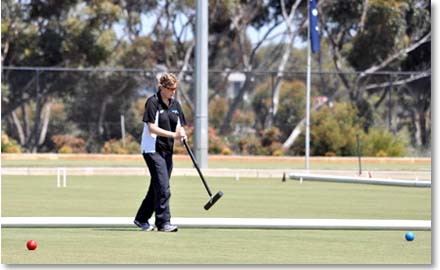
|
| Jenny Clarke stalks a ball intended to clear the opponent from scoring position. |
Further, in the niche sport of croquet, players often become 'elite' croquet coaches simply by virtue of being the best available player or a local top level player, not necessarily through having any specific understanding of how to coach. Very often this leads to croquet instruction as a rather direct delivery, in which the coach instructs, demonstrates and generally encourages players to adopt the 'correct' technique and approach to play. The bread and butter of the University of Canterbury's coaching degree programme is an "athlete-centred approach", aimed at developing players who learn through structured activities or modified games, thinking and questioning the activities they are engaged in, and reflecting on their learning.
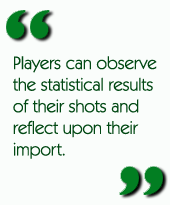 The value and benefit of training can be stifled if the player is being told 'all the answers' and shown the one 'correct way' to play; instead, that learning can be enhanced in a supportive environment, with activities structured to allow learning with multiple 'right' answers to open questions which encourage the player to think for themselves and develop their own strategies to explore - the very tenets of the Game Sense approach to coaching.
The value and benefit of training can be stifled if the player is being told 'all the answers' and shown the one 'correct way' to play; instead, that learning can be enhanced in a supportive environment, with activities structured to allow learning with multiple 'right' answers to open questions which encourage the player to think for themselves and develop their own strategies to explore - the very tenets of the Game Sense approach to coaching.
The Cowing Performance Analysis tool can be used to support coaching in all of these areas.
Exactly what is this tool, and how does it work?
The CPA tool works by classifying every stroke played by an individual in a game of Golf Croquet on the basis of the intended outcome of the stroke; assessing whether the stroke was successful or not, and displaying the results in a series of pie charts or graphs. As an effective coaching tool, it is useful to have three to four players, with two playing a normal game of Golf Croquet, and the other one or two acting as "analysts" and assessing each stroke.
Initially it is useful to have one analyst following one player, but the analysis task is very easy, and it quickly becomes possible for one analyst to use separate columns on the grid below to assess both players in a game of Golf Croquet at the same time.
The CPA tool starts with a simple notational analysis grid - a list, in rows, of strokes that might be played in a Golf Croquet game, and two columns: "Success", "Fail". An example grid is shown here:
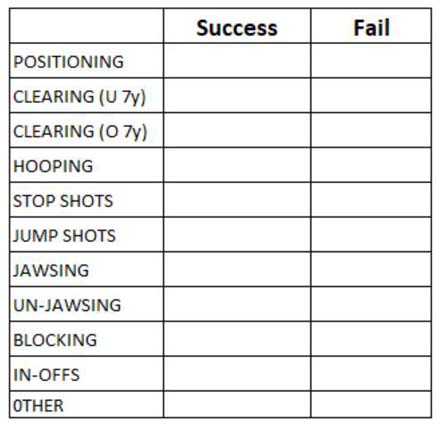
|
| Table 1: CPA analysis grid. |
The rows in the version most commonly used are:
POSITIONING: hitting the striker’s ball with the intention that it lands on a pre-chosen spot.
CLEARING (under 7 yards): hitting an opponent ball away with a stroke which starts less than 7 yards from the striker's ball.
CLEARING (7 yards and over): hitting an opponent ball away from a longer distance.
HOOPING: attempting to hit the striker’s ball through a hoop to score a hoop point.
STOP SHOT: a shot played where two balls are less than 2 yards apart and the striker hits their ball with the intention that striker's ball will stop almost immediately on contact with the attacked ball, which travels a significant distance away.
JUMP SHOTS: causing the striker's ball to jump over another ball or a hoop to achieve a certain goal - generally to score a hoop, but not always.
JAWSING: deliberately playing the striker's ball into the jaws of a hoop.
UN-JAWSING: hitting an opponent ball out of the jaws of a hoop.
BLOCKING: playing a positional stroke which blocks an opponent ball, generally to prevent it either clearing another ball or running a hoop.
IN-OFFS: playing a stroke where an opponent ball is hit away from the hoop and the striker's own ball scores the hoop.
OTHER: this row is for strokes that don't occur very often and aren't easily classified into one of the notated strokes. For any strokes classified as "other" a note should be added to explain what was intended to happen in that stroke. 'Other' can be used, for example, for hitting partner ball to rush it into hoop-running position.
The analyst must classify every stroke into exactly one box - e.g. "Hooping - successful", or "Jawsing - unsuccessful". The use of the "other" box is discouraged except when no other category can easily be used. Since the tool has been developed to assess in-game performance, the analyst must not communicate with the players, for example to check on the actual intent of a given stroke, as that would interfere with the concentration of the player and potentially influence the gameplay.
That's all that is required to gather the performance analysis data for the game.
Several people have produced analyses of croquet performance in the past. Michael Wright (New Zealand) produced spreadsheets of success/fail in MacRobertson Shield competitions (Association Croquet World Team Championship) for shooting at balls at different distances - mainly collated from text commentaries. Others have used similar tools to the CPA for notational analysis. What is new here is the way in which Andrew Cowing used this tool for coaching improving players and how it has evolved to be used to also assess elite play.
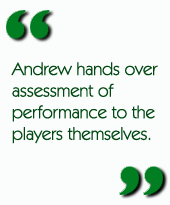 Andrew uses the CPA tool in a player-centred manner, handing over responsibility for assessing performance to the players themselves. Through their observations of the performance of their colleagues, he encourages players to think about and better understand their own tactics. The visual presentation of the performance data provides a compelling demonstration of the most important strokes to practise and shows players how they are performing relative to their peers.
Andrew uses the CPA tool in a player-centred manner, handing over responsibility for assessing performance to the players themselves. Through their observations of the performance of their colleagues, he encourages players to think about and better understand their own tactics. The visual presentation of the performance data provides a compelling demonstration of the most important strokes to practise and shows players how they are performing relative to their peers.
How to code games
The grid is simple - for each stroke, the analyst must make their best judgement of the intent of the player and decide if the player was successful, or unsuccessful, in achieving that stroke. Having done this, a mark is added to the box that corresponds to that assessment.
At the end of the game the number of marks in each box is counted, and we now have data to carry out a full analysis of the game. For example, we can determine the proportion of strokes in the game where jump strokes were attempted, the proportion of failed attempts at playing a ball into the jaws of the hoop, and how many strokes in total were successful in the game.
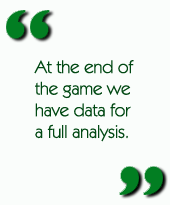 The challenge is in classifying each stroke, particularly those where it is unclear what the intent of the stroke was, and how to classify cases where the primary goal was not achieved but a secondary goal was achieved. The list of ways to classify strokes could also be endless. One modification which has enhanced the analysis as originally delivered by Cowing is separating the clearing attempts into categories for shots under and over a certain distance.
The challenge is in classifying each stroke, particularly those where it is unclear what the intent of the stroke was, and how to classify cases where the primary goal was not achieved but a secondary goal was achieved. The list of ways to classify strokes could also be endless. One modification which has enhanced the analysis as originally delivered by Cowing is separating the clearing attempts into categories for shots under and over a certain distance.
For relative beginner and high handicap (9 or 10 handicap and over) players, the under/over number should be 4 yards. All players should be aspiring to hit a target ball less than 4 yards away, and it is useful to assess in-game accuracy improvement at this range. Over 4 yards is a serious challenge to many players. The method found to be most useful with this tool is to separate the distances into: "should hit" and "would like to hit but it's ok to miss sometimes".
For strong improving and elite players, 7 yards - the shortest distance from the boundary to the outer four hoops - produces the best results for under/over clearance data. It should also be noted that the act of classifying a stroke as "successful" is not necessarily hit/miss - it is whether the clearance can be regarded as producing a result favourable to the striker or not. A clearance that hits but only moves the target ball a short distance will often be regarded as a failure.
 One could, of course, introduce further categories, e.g. splitting the clearing into under 7 yards, 7-12 yards, over 12 yards, or perhaps splitting the hoop running row into two rows, perhaps under or over 3 yards. You may also consider having a specific "doubles" box to classify shooting at long targets where there is an opponent ball next to a hoop and either hitting the opponent ball or scoring the hoop point would be considered a 'success'. The challenge, however, is that the statistical power of the tool diminishes as more categories are added as then each box has only a few entries, making it very hard to learn anything from the data.
One could, of course, introduce further categories, e.g. splitting the clearing into under 7 yards, 7-12 yards, over 12 yards, or perhaps splitting the hoop running row into two rows, perhaps under or over 3 yards. You may also consider having a specific "doubles" box to classify shooting at long targets where there is an opponent ball next to a hoop and either hitting the opponent ball or scoring the hoop point would be considered a 'success'. The challenge, however, is that the statistical power of the tool diminishes as more categories are added as then each box has only a few entries, making it very hard to learn anything from the data.
From here there are two paths to explore. The first is pure performance analysis - simply analysing the results of the game and generating numbers which can be used to assess the performance of the player. The second path explores how this tool provides benefits promoted by modern coaching theories in engaging and empowering players to take control of their own learning and decision-making: essentially, developing thinking players.
Getting the numbers - expert analysts
The reliability and consistency by which each stroke is assessed is likely to be improved with both experience from frequent use of the performance analysis tool, and also with greater expertise in the game. That is, an experienced analyst would be expected to produce very similar results when coding a game, and then repeating the coding of the identical game some days or weeks later. While tactical differences in style between the analyst and the player will have some influence on how strokes are assessed, this is likely to introduce only a small error or bias in the overall analysis.
Several research studies have shown that having someone the player respects as an expert code their game may lead some players to have more respect for their results and their interpretation. Having the coach, or an "expert analyst", perform the game coding might therefore make the CPA more effective as a direct coaching tool for elite players or for scouting opposition, and may offer some insight into the more complex and generally more tactical interaction of doubles play.
Another benefit for a player of having his or her games analysed with the CPA tool is that with the analysis a much more objective understanding can be gained of the game that has been played. Someone analysing a game using an analysis tool such as the CPA is likely to observe and identify facts that may not have been otherwise noticed.
For example, in the second semi-final game of the 2019 British Open singles between Peter Dowd and John-Paul Moberly there was a distinct moment in the game where, after achieving most strokes attempted in the game, two of Peter's shots were unsuccessful. Both his confidence and his form, as evidenced by his body language and subsequent shot choices, substantially deteriorated. This was obvious to the analyst, who noted that suddenly more of Peter's shots were ending up in the "failed" column, but this time-related change in performance isn't visible in the final analysis grid.
Understanding potential change-points in their own game gives players a strong cue to engage psychological tools to ensure their performance doesn't plummet and to maintain their competitiveness in the game. Understanding when moments such as this occur also gives the coach an opportunity to work with their player on developing mental toughness and strategies to enable them to refocus and reapply that pressure after a brief lull.
Player analysts develop thinking players
In the Pods conducted by Cowing, and more recently in a workshop conducted with the highly motivated local youth players and a number of other very keen local players at the United Croquet Club in Christchurch, the players themselves took on roles as analysts. Players were separated into groups of four, with two players initially playing a game of Golf Croquet (often competing for a small prize to encourage full effort), and the other pair assigned as analysts. The analysts each took a grid, as described above, and classified each stroke by their nominated player into a row of the grid, and as either 'success' or 'fail'.
This is a highly effective coaching tool for the analysts. For players new to using this tool, it is particularly useful when there is an analyst for each player, as the two analysts can sit together and discuss and assess the strokes of their players.

|
| Jenny watches a game in Oregon a decade ago, where husband Chris won a share of the purse. |
The analysts have to watch each stroke, and commit to a decision as to what the player was attempting to achieve, and whether or not their player was successful in what they attempted. While one could argue that if they were unsure, the analysts could simply ask the player about their intention, this is to be discouraged, as it interrupts the concentration of the player, and also reduces the thinking the analyst needs to do to understand the intent and assess the relative success of the stroke.
The slight statistical loss through having the analyst make their own assessment is more than balanced by the learning effect of intently watching a player, observing their technical performance, trying to understand what they were attempting to achieve, and the inevitable moments of the analyst thinking 'hmm, what would I do there?'.
Having two analysts coding separate players in a game, but sitting together, enables them to discuss how they would assess each stroke: "Well, he did clear red, but his blue ball went absolutely miles away, and it was an easy shot, do you think that was a success?"
 Player analysts also provide the opportunity for players to discuss the outcomes with their peers after the activity, and perhaps discuss the areas where they were unsure about the intent/outcome of any strokes. As a result, having player analysts provides a rich environment for exchange of ideas and productive discussions between players. The latter is harder to achieve when a senior player or coach has assessed strokes as successful or, in particular, as failures, and open discussion in the coach-as-analyst case is also more limited due to power relationships between the player and coach.
Player analysts also provide the opportunity for players to discuss the outcomes with their peers after the activity, and perhaps discuss the areas where they were unsure about the intent/outcome of any strokes. As a result, having player analysts provides a rich environment for exchange of ideas and productive discussions between players. The latter is harder to achieve when a senior player or coach has assessed strokes as successful or, in particular, as failures, and open discussion in the coach-as-analyst case is also more limited due to power relationships between the player and coach.
Coding the game of someone of higher ability than oneself can often provide a richer learning experience for the analyst than simply watching the game. However, one must always be mindful of the different tactical options available to players with vastly different skills. For example, when an excellent shot maker is in a high quality match, there may be cases where taking position 5 yards back from a hoop is a success, both tactically and physically, while for a weaker shot this is generally a tactical error, leaving a large space available for the opposition to play in closer to the hoop.
Visualising the results
At the end of a game, the coded results for a single player might look like those in Table 2 below.
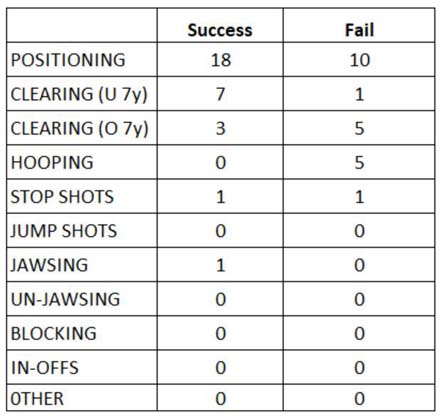
|
| Table 2: Completed analysis grid for a golf croquet game. |
These results alone show a lot of useful information. There were 52 strokes taken in total (the sum of all numbers on the grid), of which 30 were in the column "Success" and 22 were "Fail". Despite this player being enthusiastic about practising jump strokes, none of the 52 strokes played in this game was a jump stroke. Further, while distance from the hoop is not recorded, a clear message from this analysis is that hoop running was very unsuccessful in this game (more on hoop running later). At the top of the grid we see 18 successful positioning strokes - but we cannot immediately determine if this was good or bad - this is where the visual representation of results from the CPA tool are very valuable.
Generating graphical information from analysis data
After the very player-centred sessions run by Cowing, players were then encouraged to work together to produce their own pie charts showing the percentage of each type of stroke (successful and failed) in the game as a different slice. One or two charts from volunteers were then analysed in a whole-group discussion, and the pie charts were then further separated with the portions of the slices corresponding to unsuccessful and successful strokes for each shot type being identified.
In analysis sessions such as this it is very much the leader of the session who sets the tone of how positive and supportive this environment will be, and it also takes some courage from individual players to be "the one" who is under scrutiny. Others are able to look at their own charts during the discussion and also to talk to the coach separately.
 To encourage engagement with the results from the CPA tool it is important for the coach to understand how to present feedback to the player. For weaker players, it is particularly important to highlight positive areas of performance, as well as to be aware of supporting players who may have been relatively unsuccessful in the game under scrutiny.
To encourage engagement with the results from the CPA tool it is important for the coach to understand how to present feedback to the player. For weaker players, it is particularly important to highlight positive areas of performance, as well as to be aware of supporting players who may have been relatively unsuccessful in the game under scrutiny.
While the collaborative activity of calculating percentage contributions from each stroke can be a valuable learning and discussion opportunity on its own, and the unveiling of the first pie chart does make a powerful impact, the time commitment to undertake this task can also provide an unwanted distraction from the performance analysis goals of the session. Several croquet players have since collaborated to create an Excel spreadsheet to fast-track and automate this process.
From the completed analysis grid in Table 2, the data is entered into the orange cells on the page shown in Table 3 and the calculations on Table 4. Pie charts representing proportions of shot types played, opportunities to improve performance based on the game analysis, and an overall performance score are automatically generated by the spreadsheet. These outputs are described below. (The analysis spreadsheet produces the same information in the form of histograms with bars of different heights to represent the number of each type of stroke played, however we will discuss only the pie charts in this article.)
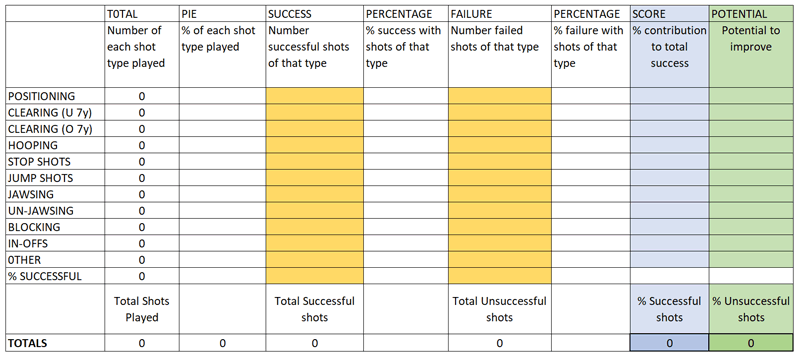
|
| Table 3: CPA spreadsheet. Values are transferred from analysis grid (see Table 2) into the orange columns. (Click here for a larger image.) |
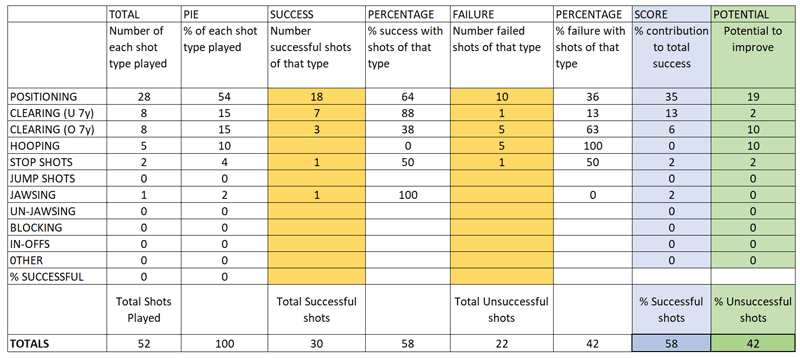
|
| Table 4: Output from CPA tool after entering game results from analysis grid into yellow columns. (Click here for a larger image.) |
"Contribution" pie chart shows proportion of each stroke type played
The first graphical output is a Contribution pie chart - this shows Cowing's original pie chart as a circle separated into slices representing the proportion of the total strokes of each type played (success+fail). For our example, the Contribution pie chart is shown in Chart 1 below.
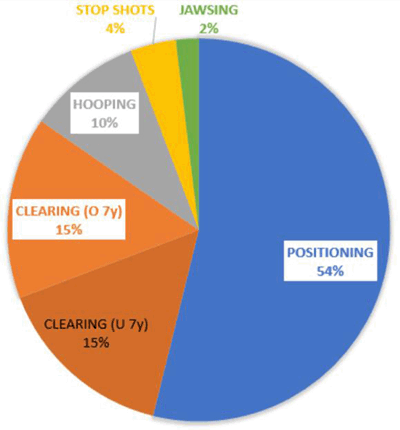
|
| Chart 1: Pie chart showing proportion of each type of stroke played (each segment includes successful and unsuccessful strokes). |
The visual display is a powerful indication to players of where their practice should be directed. In this case, more than half of the total strokes played in the game were positional strokes. The relative proportions of each major type of stroke (positional, hooping, clearing) are very similar in analyses to date for a very wide range of players and playing abilities. Some of the individual strokes are discussed later in this article.
"Opportunities to improve" pie chart shows proportion of unsuccessful strokes of each type
The next step is to split each part of the pie (e.g. Hooping, Clearing, etc) into portions exploring the proportions of each stroke which were successful and which were unsuccessful. This can be done by hand by shading the portions of each slice of the pie chart to indicate the failed strokes. Here it immediately becomes obvious where the biggest opportunities for improvement can be made.
In our example the player had 10 failed positional strokes out of a total of 52 strokes - that's 19% of the total, and this contributes to a rather large slice on a pie chart. This visualisation shows players where they can target their stroke play to improve their overall number of successful strokes played.
The current version of the CPA tool simplifies Cowing's separation of strokes into success and fail with a pie chart called "opportunities to improve". Here the successful strokes are combined into a grey area, and the other pie slices show the proportions of unsuccessful strokes for each stroke type. The larger the segment, the more improving this stroke type can contribute to increasing the size of the grey "success" segment and improving overall performance.
Chart 2 below shows "opportunities to improve" for the player in our example. Here the grey area represents the 58% of all strokes which were successful, while the other segments show where unsuccessful strokes were played and where improvement can therefore be sought. This chart highlights the need for this player to improve his position taking, but also shows areas for attention in both hoop-running and long-distance clearing. We will discuss different shot types below.
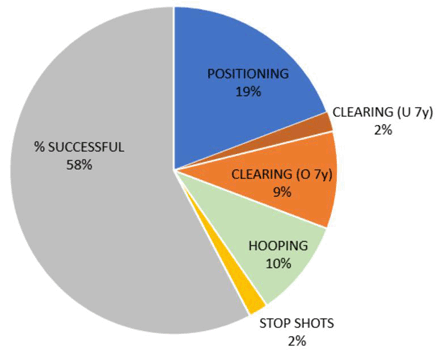
|
| Chart 2: "Opportunities to improve" pie chart showing the percentage of successful strokes of all types in grey and showing the contribution to the total number of strokes of unsuccessful strokes of each type in the coloured slices. |
Calculating a Success score
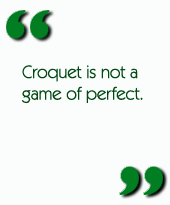 Finally, an overall 'success score' is calculated using the formula (number of successful strokes)/(total number of strokes played) * 100. This is a number between 1 and 100 and simply represents the percentage of the total number of strokes played in the game by that individual player that were successful. 100 (i.e. 100%) would be perfect, and is what many beginners and low-level players believe the "top" players achieve.
Finally, an overall 'success score' is calculated using the formula (number of successful strokes)/(total number of strokes played) * 100. This is a number between 1 and 100 and simply represents the percentage of the total number of strokes played in the game by that individual player that were successful. 100 (i.e. 100%) would be perfect, and is what many beginners and low-level players believe the "top" players achieve.
However, to adapt Bob Rotella's excellent golf psychology book title: 'Croquet is not a game of perfect'. The CPA tool is a powerful visual method to effectively convince lower level players that top players play far from perfectly - even when winning top class events. The success score for the player in our example was 58.
Assessing performance in stroke types
with the CPA tool
In this section we will discuss the different stroke types assessed in the CPA. While the analysis of one individual game can be very interesting, analysis across multiple games, across a range of levels of playing ability, or for one player against multiple opponents and across several competitions can highlight patterns which provide important guidance for players and coaches. Individual players can begin to understand their strengths and weaknesses to help guide practice sessions, as well as gaining insight into solid tactical options for competition play.
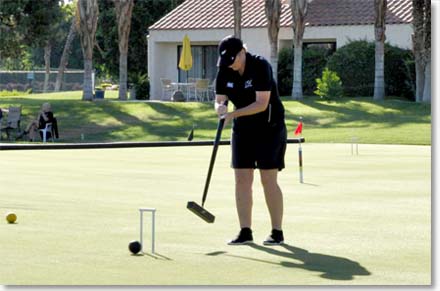
|
| Jenny runs a hoop in the 2017 Tier One World Team Championship, for 6-person teams from the top four croquet-playing countries in the world: England, New Zealand, Australia, and the USA. Photo by Chris Clarke. |
At all levels of Golf Croquet, from beginner to national championship finals, positional strokes account for more than half the strokes played in a competitive game of Golf Croquet. Only one participant in the United Croquet Club workshop spent less time (38%) taking position, with a significantly larger amount of time than anyone else spent clearing. This put the player's shooting under considerable pressure, particularly as hit clearances were generally struck very powerfully, and ultimately he lost the game 7-4. Following the workshop and discussions about tactical options this player has adopted a more conventional tactical approach, and has worked hard to improve his medium-pace shooting – resulting in considerable tournament success and frequent handicap reductions.
Taking position should be an 'easy' stroke to play while, as we discuss below, long distance clearing will always be a slice of the performance pie which has room for improvement, as shooting at balls that are many yards away is challenging for all players.
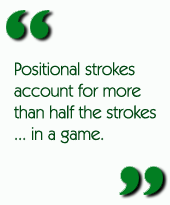 Because more than half of the game is about taking position, a significant amount of time should be spent practising this simple closed skill. No opponents are needed, and a player determined to improve can endlessly work on controlling their power and direction. However, from years of coaching and talking to Golf Croquet players, it is very evident that discipline is needed to prevent a well-intentioned session of position-taking practice evolving into one that involves shooting at long hoops and trying to hit long clearances. Hitting powerful clearances in the middle is an activity which gives immediate positive feedback, while position taking can feel mundane and irrelevant. However, as the most commonly played shot in the game, it should be a player's most accurate stroke.
Because more than half of the game is about taking position, a significant amount of time should be spent practising this simple closed skill. No opponents are needed, and a player determined to improve can endlessly work on controlling their power and direction. However, from years of coaching and talking to Golf Croquet players, it is very evident that discipline is needed to prevent a well-intentioned session of position-taking practice evolving into one that involves shooting at long hoops and trying to hit long clearances. Hitting powerful clearances in the middle is an activity which gives immediate positive feedback, while position taking can feel mundane and irrelevant. However, as the most commonly played shot in the game, it should be a player's most accurate stroke.
John-Paul Moberly lost the first game of the 2019 British Open Final 7-2, having only 70% success in taking position at hoops, while Reg Bamford successfully took position 20 times from 20 strokes. Moberly had a slightly superior clearing percentage at 67% (10/10 below 8 yards and 0/5 above 8 yards) while Bamford's was 60% (4/4 below 8 yards and 5/11 above 8 yards), but the simple fact that there were 40 position-taking strokes compared to 30 clearing strokes in the match made a significant difference.
Clearing opponent balls from hoop-shooting distance
It is clear from analysis of more than 50 Golf Croquet games from club player to international representative level that being able to clear balls from 7 yards away or less (hitting the opponent away and generally causing that ball to move further than the striker's ball travels) is a critical skill in the game of Golf Croquet.
This is one area where 90% is a minimum number for percentage of successful clearances to win at high levels. In the recent WCF Openshaw Shield competition (the Golf Croquet World Team Championship), the power and accuracy of clearances under 7 yards was astonishing.
Clearing above 7 yards is an area where weaker players (handicaps 5 and above) can regard hits as bonuses, and even elite players cannot expect to be scoring much higher than 60% in games. That's 4 shots in every 10 which either miss, or only uselessly glance the opponent ball. This includes Reg Bamford's performance in winning the 2019 British Open Golf Croquet singles championship final.
The player unable to hit more than half of his or her under 4-yard clearances (which necessarily includes strokes of less than a yard!), is not likely to progress far.
Approximately 30% of strokes played in a game of Golf Croquet are attempted clearances, again making this an important area of practice.
Hooping attempts account for more than 10% of strokes
Analysis of games at many levels suggests that typically 10-20% of strokes played in Golf Croquet are attempts to run hoops. Hoop running is separated in this tool into running the hoop along the ground, and jump strokes (although clearance strokes where a blocking ball needs to be jumped are also classified as Jumping).
Hoop running includes very long-range attempts, where the opponent has two balls in front of the hoop and the only way back is an unlikely hoop run from distance, down to easy 2-inch shots. In our example, the player had 5 shots as his goal, and was unsuccessful in all 5. The clear first thought is, 'He needs to practise his hoop running!'
Perhaps the next thought might be 'I wonder how many of those hoops were attempted from under 3 yards?'. It would perhaps be interesting to separate hoop running into "close" and "distant" strokes; however, this is very dependent on the level of the player, the ground conditions and hoop type.
For United Croquet Club in full summer with hard ground and Atkins Quadway hoops, even for elite players a 2-yard hoop is a very good challenge. In clubs where the ground is softer and the hoops are easier, for example the 2019 British Open Championships, it was more reasonable to take position further back and expect to run a 4-yard hoop at every attempt. For an average to strong player wanting to explore their performance in detail, over several games, separating into hoop attempts from under/over 3 yards would provide interesting information. For beginners and high handicap club players a better yardstick would be under/over 1 yard.
 Despite the wide range of distances for a generic 'hooping' category, the analysis tool provides useful information. We have discussed accuracy of hoop running above, but another statistic worthy of discussion and involving consideration of tactical play is essentially 'shots on goal', in soccer terminology. In croquet, this is the total number of attempts at hoop running, representing the number of scoring opportunities a player had.
Despite the wide range of distances for a generic 'hooping' category, the analysis tool provides useful information. We have discussed accuracy of hoop running above, but another statistic worthy of discussion and involving consideration of tactical play is essentially 'shots on goal', in soccer terminology. In croquet, this is the total number of attempts at hoop running, representing the number of scoring opportunities a player had.
This is a little complicated, as it is arguable that many weaker players attempt to run long hoops when they should instead be taking a more patient approach and taking better position, or gently clearing an opponent ball. That said, it is an undeniable fact that looking at the statistics for the player in our example, he could not have been the winner of this match - he attempted only 5 shots at any hoops.
This is much more interesting at more elite levels, where stroke-making precision is generally higher, and tactics are often very specific to the players in the game. If the number of hoops attempted is low, the player should be considering opportunities to increase this number - for example by taking on longer hoops rather than clearing (as often, clearing an opponent means you have given up your only chance when you are actually in front of the hoop), or by taking position when the opponent is unable to or less likely to clear (further from the opponent, and even at distances where the opponent will leave a free shot at the hoop).
A good example of tactical misjudgement around shots on target was the 2016 Openshaw Shield (Golf Croquet World Teams Championship) final. In the final round of games, Egyptian Mohammed Nasr played New Zealand's Jenny Clarke. Clarke been running hoops poorly in the two previous singles matches and a clear Egyptian team tactic was to simply take position and ignore Clarke's ball if it was any appreciable distance from the hoop. Against a stronger opponent, the kiwi's tactic was simply to take advantage of any opportunities to run any hoop. New Zealand were ultimately victorious in that match and in the championship.
How much practice should be devoted to jumping?
This section deserves comment as it is very hard to convince up and coming, particularly young, players that endlessly practising showy jump strokes is a poor use of time. While having big jump strokes available in the arsenal can be an important asset in big matches, in around 30 games analysed, the average number of jump strokes per game per player was approximately 1.5. That's around 3% of the total number of strokes played in any game of Golf Croquet. Jump shots are very worthy of practice, but not at the expense of position and clearances.
Having a clear visual representation of the proportion of strokes of each type played makes the CPA tool a very useful way to demonstrate to players that jump strokes are not the most critical part of their armoury to develop. Indeed, in Reg Bamford's 2-0 Championship finals win, in the 2019 British Open Golf Croquet Championship, he attempted no jump strokes, and Moberly was successful in only one of his two attempts.
Other stroke types
The other stroke types in the Cowing Performance Analysis tool are less commonly played, but are useful in scouting opposition players, and when coaching tactical play.
The "Blocking" stroke refers to taking position where one's ball deliberately blocks the path of the opponent, either from running a hoop or clearing another ball. As with other strokes, sometimes the block can be played from an inch, so is very easy, and other times it is from some distance. Nevertheless, scouting would have demonstrated to any coach preparing their player that Nelson Morrow (NZ) was masterful at playing blocking shots in the 2018 British Open Golf Croquet Championships (at the same time, he was missing many clearances) - suggesting perhaps the player should be taking position closer to hoops to avoid being blocked, and should anticipate the possibility of a ball being dribbled into an awkward position more often than they are used to.
The "Jawsing" stroke is also interesting - some players are renowned 'hoop crawlers' - playing for advantageous position in the jaws of a hoop, rather than attempting to run the hoop cleanly, particularly in odd numbered hoops. If a player is good at jawsing, as the opponent it is good to be aware of the need to take position in front of the hoop where a jump shot is possible, or potentially have a ball ready to clear something lodged in a hoop. For a player who is not good at jawsing, having an objective success/fail count could be a good way for their coach to convince them to actually run a hoop when they have the opportunity.
 I have already mentioned that "Stop Shots" are a category I generally reserve for analysing low level players. For better players, this naturally forms part of the "clearing" category for me. A poor stop shot--for example an imperfect contact losing the opportunity to stay in front of a hoop when a short clearance is available--can be marked down as a failed clearance, as it probably cleared the opponent, but missed a critical part of its goal.
I have already mentioned that "Stop Shots" are a category I generally reserve for analysing low level players. For better players, this naturally forms part of the "clearing" category for me. A poor stop shot--for example an imperfect contact losing the opportunity to stay in front of a hoop when a short clearance is available--can be marked down as a failed clearance, as it probably cleared the opponent, but missed a critical part of its goal.
Similarly, 'Unjawsing' is important for high handicapped players as they often completely lose the clean technique of their swing when trying to dislodge a ball from the jaws of a hoop - often over-aggressively attempting to hit that opponent ball to a spot 50 metres away!
Revisiting the Success score - winning and losing
The overall Success score number, representing the percentage of successful strokes, is a powerful predictor of win/loss of an individual game of golf croquet. In more than 50 analysed games, only one game was won by the player with the lower success score. In that one case, the losing player had unluckily hit his opponent through 2 hoops. Otherwise, even where there was only a 2% difference between the success scores of the two players, the better performing player, as assessed by this tool, won the game.
This can be interpreted as meaning that the more successful strokes one plays, independent of how successful these strokes actually are in terms of hooping/clearing/positioning/etc, the more likely that player is to win. This provides strong support for getting the basics right and being successful on the strokes that can be practised over and over, and particularly on those strokes that are most frequent in the game - position, position, position!
The Success score also provides an indication of where the player fits into the current group of players they are competing with. An interpretation of the success score is given in Table 5.
|
||||||||||||
| Table 5: Interpretation of success score for players competing with similar-ability opponents. | ||||||||||||
 Looking at the lower levels, a success score of 50% for a club-level player generally indicates their positional play is poor, but can also suggest the player may be too aggressive in playing clearing shots. Equally, against a stronger opponent, this indicates the player is being outplayed tactically or is trying unsuccessfully to play above their true ability to generate an against-the-odds win.
Looking at the lower levels, a success score of 50% for a club-level player generally indicates their positional play is poor, but can also suggest the player may be too aggressive in playing clearing shots. Equally, against a stronger opponent, this indicates the player is being outplayed tactically or is trying unsuccessfully to play above their true ability to generate an against-the-odds win.
In the case of well-matched (similar handicap, for example) players, the Success score, combined with the more detailed information from the Contribution and Opportunities for improvement pie charts provides a useful indication where weaknesses are, and can help to provide a roadmap for progressing into the next level of play.
Equally interesting in Table 5 is the top range of the success score - 75% is a tournament winning performance level. This means that players who are successful in only 3 out of 4 strokes in games within a tournament are likely to win that tournament! To see this in practice, Table 6 below lists some winning and losing success scores for recent major tournaments:
|
|||||||||||||||||||||||||||||||||||
| Table 6: Success scores and game results for players competing with similar-ability opponents. | |||||||||||||||||||||||||||||||||||
This clearly demonstrates that it is not necessarily the choice of strokes, but the quality of strokes that is important. Obviously, tactical factors will be important - taking position too close to an opponent ball could lead to the opponent easily clearing you to 20 to 30 yards away, meaning your following stroke has a much lower probability of success.
Note that Reg Bamford, the number one Golf Croquet player in the world, a former Golf Croquet world champion and one of the best Golf Croquet players on the planet, had success scores for the two games of his 2019 British Open final match of 80% and 82% - only four out of five shots he played were classified as successful, and he won the match with much acclaim for his performance. This clearly demonstrates that croquet is not a game of perfect performance, which is valuable knowledge for any player whose progress is limited by the belief that they cannot progress in Golf Croquet unless they achieve every stroke with absolute precision.
The Performance Analysis workshop in July 2019 at United Croquet Club featured a match between two 15-year-old players, both playing off handicaps of 5. One player scored 56% success - a modest result, but the player was surprised to lose the game 7-0. The opponent got 19 out of 25 positional shots classified as "success" by his analyst (another 15-year-old), but scored an overall 81%-- the second highest score recorded in over 50 games analysed with this tool.
Five months later, the winner of that game won a national championship and received a well-deserved non-automatic handicap reduction to Minus 3!
|
Assessing the success or failure of your strokes The first step in completing the analysis grid in the CPA tool is deciding 'what is the player trying to do'? If you decide they are trying to take position, then the row that will be filled in is "Position". After the shot, your question is 'was the outcome of the shot successful?' If it was successful you put a mark into the success box of the position row. In this way the analysis tool builds into itself the element of luck. You don't always end up with the anticipated outcome, but a stroke has been played (though sometimes the analyst has to make a decision as to what they interpret was the intent of the striker), and there is an outcome which might be favourable to the striker, or to their opponent.
The most challenging strokes for an analyst to classify are the shots that are "mostly successful" and shots that result in unintended consequences. Maybe a clearance where the striker's ball travels approximately the same distance as the opponent ball was successful - here context and the relative usefulness of the final positions of the balls help inform a decision on success/failure. More difficult to appraise is a shot attempting to take position but overrunning that positional stroke - and running the hoop. The 2009 Women's Golf Croquet World Championship had several strokes with just this outcome - running distant hoops with the first ball to play forward. Is this a successful hoop run, a poor positional stroke, and/or a successful positional stroke? There is a very good case to be made for the third option. If the ball had finished in the jaws, it was clearly a very successful positional stroke, albeit somewhat longer than possibly intended, but intended to take position, and ending up with an advantageous result. In the end, it is up to the analyst to make a decision on how they wish to classify the stroke. In any case, in these examples where the hoop is ultimately scored, the stroke was clearly a success, as it resulted in a very favourable outcome for the player.
For a double target of ball and hoop, either clearing the opponent ball or running the hoop is successful. In this case I would recommend that if either occurs, a success mark is put into the corresponding "hooping" or "clearing" row. However, a result of a miss, a rush-peel, or a contact with an opponent ball which doesn't move it appreciably and leaves the opponent still in control of the hoop would be scored as "clearing - fail". In practice, I rarely classify a stroke as a "stop shot", using instead the "clearing" fields. However, with weaker players where opponents tend to take position at hoops, ignoring a nearby opponent ball and offering a relatively easy stop-shot clearance, this is an important field. In that case it should be understood that a tick in the "stop shot" row is giving information about a short clearance, and since players do not usually miss short stop shots, at most levels, success/fail is more about how effectively the striker's ball stops after hitting the opponent away.
Taking position also has an element of subjectivity, where for a 'better' player with easier hoops, a 4- yard position might be classified as "success". For a club player who is unlikely to run a 4-yard hoop this just leaves the opportunity for an opponent to get between them and the hoop. In the latter case taking position so far from the hoop is unlikely to result in the next stroke for that ball winning a hoop point, so it would better be analysed as "fail", which will signal to the player a need to focus on improving their position taking.
Sometimes an incredibly difficult stroke is the only option. These strokes contribute to imperfect success scores - a score of 82% in the British Open final meant Bamford took position perfectly every time, but missed some of the very long-range clearances left to him by Moberly and failed two hoop attempts. This is a very important psychological message to improving players - croquet is not a game of perfect. 82% is superb. Summing up and pointing to the future The benefits of the Cowing Performance Analysis tool have been described above:
The CPA has only once been trialled in doubles play, in an international match in the 2020 Openshaw Shield (the Golf Croquet World Team Championship), and initial results showed clear differences in the performances of each player in the games. Further trials are warranted as they may well provide an interesting insight into the dynamics and differences of tactical and partnership performance play in singles and doubles. For a very weak player who is struggling with their game, it could be useful to work on only recording or focussing on the successful stroke percentages and working to improve those, while the player gains the self-confidence to be able to later deal with receiving constructive feedback on their weaknesses. Indeed, the introduction and first use of this tool with a player needs some care - receiving a "bad" score with the first exposure to this tool can lead to a player taking a quite negative approach to performance analysis, rather than seeing it as an opportunity to review their own potentially-one-off game performance.
For an individual player wishing to use the CPA tool for improvement, gathering a series of game analyses that can be studied to detect patterns, understand performance against different levels of opponents and to assess the effect of training programmes will be very useful. It would be recommended, if a fellow player or coach could be found to act as analyst, to also have the opponent's play included in the analysis, to help provide a context for the player's own results. Overall, this tool provides an excellent half-day coaching session, a method of assessing player performance and development and encouraging useful practice routines and habits, a potential scouting tool for international play, and an objective instrument by which a player can track their progress in Golf Croquet. The Cowing Performance Analysis tool spreadsheet and instructions are available from Jenny Clarke: physjcw@gmail.com. |
Jenny Clarke has been playing international representative croquet for 17 years and achieved top ranking several years ago. Her Golf Croquet honours include 4 medals in women's world championships and quarter final placings in several open world championships. She is usually the highest ranked female in the world rankings. With husband Chris Clarke she won a Gold Medal in the 2016 Openshaw Shield (Golf Croquet World Team Championships), as well as multiple national doubles titles. She is currently ranked #28 in the world rankings of Golf Croquet and #14 in the world in Association Croquet. In 2019 she was awarded New Zealand Player of the Year by Croquet New Zealand and was inducted into the Croquet New Zealand Hall of Fame. As a sport science lecturer at the University of Canterbury in New Zealand, Jenny has carried out research in the areas of coaching and teaching, with a recent sabbatical in England where she explored the excellent Pod system of coaching introduced to the United Kingdom in 2014. She is also a Grade Three Golf Croquet coach with the English Croquet Association and has extensive coaching experience in both Golf Croquet and Association Croquet at all levels in New Zealand.
 Imagine, for example, that Black is a yard in front of the hoop and in a position to score the hoop point in the next turn. Red has a 9-yard shot to try to clear Black. You, as analyst, decide that this is a 7+ yard clearance attempt. Red is mis-hit and actually hits Blue before reaching the Black ball - but fortuitously causes Blue to rebound onto the Black, causing both Blue and Black to be scattered away. Has the shot been successful? - yes. Was the outcome of the shot what was intended? - no. But that actually doesn't matter. Equally, if the attempted clearance on black simply missed all balls and ran the hoop, thus scoring the hoop point - this was still a success.
Imagine, for example, that Black is a yard in front of the hoop and in a position to score the hoop point in the next turn. Red has a 9-yard shot to try to clear Black. You, as analyst, decide that this is a 7+ yard clearance attempt. Red is mis-hit and actually hits Blue before reaching the Black ball - but fortuitously causes Blue to rebound onto the Black, causing both Blue and Black to be scattered away. Has the shot been successful? - yes. Was the outcome of the shot what was intended? - no. But that actually doesn't matter. Equally, if the attempted clearance on black simply missed all balls and ran the hoop, thus scoring the hoop point - this was still a success.
 There is one class of stroke for which I would recommend waiting on the outcome of the stroke to make a decision on the stroke type; namely shooting at double targets such as two close-by opposition balls, or a ball-and-hoop target. Where there are two balls close together, the player is clearly attempting a clearance, and the success/failure is based on whether the outcome is useful or not.
There is one class of stroke for which I would recommend waiting on the outcome of the stroke to make a decision on the stroke type; namely shooting at double targets such as two close-by opposition balls, or a ball-and-hoop target. Where there are two balls close together, the player is clearly attempting a clearance, and the success/failure is based on whether the outcome is useful or not.
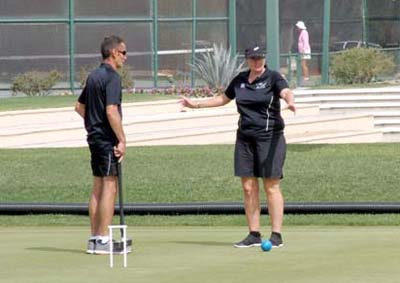
 An effective coaching element, for players who are acting as the analyst, is the need for deciding what stroke was being played, and if that stroke was successful. This encourages players to also think about tactical choices: Was the stroke successful? Was it too difficult a stroke to reasonably attempt? What other options were available?
One such example is when an opponent has both their balls in a position to easily score the next hoop point and the player has both of their balls a long way from the hoop, possibly due to misses or glancing clearances by the player a few strokes ago. Here the only real opportunity to save the hoop can be to try to run a hoop from over 20 yards, and potentially at a difficult angle. Or, of course, the famous 7-yard jump stroke from the boundary to save a game which is at 6-6 with the opponent's ball sitting in the middle of the final hoop.
An effective coaching element, for players who are acting as the analyst, is the need for deciding what stroke was being played, and if that stroke was successful. This encourages players to also think about tactical choices: Was the stroke successful? Was it too difficult a stroke to reasonably attempt? What other options were available?
One such example is when an opponent has both their balls in a position to easily score the next hoop point and the player has both of their balls a long way from the hoop, possibly due to misses or glancing clearances by the player a few strokes ago. Here the only real opportunity to save the hoop can be to try to run a hoop from over 20 yards, and potentially at a difficult angle. Or, of course, the famous 7-yard jump stroke from the boundary to save a game which is at 6-6 with the opponent's ball sitting in the middle of the final hoop.
 While we have not included an analysis of tactical performance in this discussion--and tactical play is a critical aspect of the game of Golf Croquet--it is easy to understand in the example analysed here that having nearly 1 in 5 of one's strokes fail due to not taking position accurately is a significant area in need of improvement. Additionally, much of the discussion so far has used the results of one game as an example, and in a one-off coaching workshop it is likely that each player will have the opportunity to have one game of theirs analysed, and the chance to analyse one game for a colleague.
While we have not included an analysis of tactical performance in this discussion--and tactical play is a critical aspect of the game of Golf Croquet--it is easy to understand in the example analysed here that having nearly 1 in 5 of one's strokes fail due to not taking position accurately is a significant area in need of improvement. Additionally, much of the discussion so far has used the results of one game as an example, and in a one-off coaching workshop it is likely that each player will have the opportunity to have one game of theirs analysed, and the chance to analyse one game for a colleague.